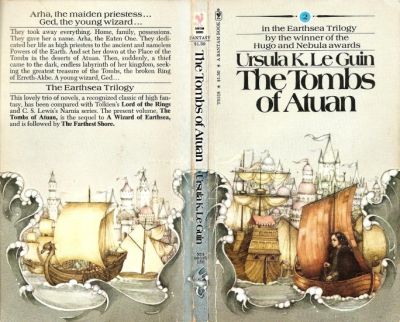The Art of Letting Go
The Tombs of Atuan (Earthsea, volume 2)
By Ursula K. Le Guin

15 Jan, 2017
Because My Tears Are Delicious To You
0 comments
1970’s The Tombs of Atuan is the second volume in Ursula K. Le Guin’s Earthsea Cycle.
The influence of the Nameless Ones has dwindled over the long ages, but they still have power in the Tombs of Atuan. There they still are worshipped. There they are served by their immortal Priestess.
The little girl once named Tenar is the latest incarnation of the Priestess. The bodies of the One Priestess of the Tombs of Atuan die, but the Priestess lives on, reborn in a newborn body at the time of the Priestess’ death. Stripped of her birth family and her name, the girl who was Tenar becomes Arha, “the eaten one,” paramount human servant of the ancient and fearsome Nameless Ones.
Life as the Priestess would be strange and terrifying for Tenar, if it were not the only life she knows. Her mentors have a very firm idea what the true Priestess should be like. They hone the little girl carefully, intending that by the time she reaches her majority and comes into her full power as the adult Priestess, she will be as doctrinaire, as merciless, as cruel as all of her previous incarnations.
They have good reason to believe that they succeeded.
One day a thief named Ged creeps into the labyrinth under the Tombs. The thief, a wizard from lands still unconquered by the Kargish Godking, seeks a lost magical talisman that might bring peace to the divided islands of Earthsea. Outraged at his sacrilegious effrontery, Tenar traps him in the labyrinth.
Tenar knows the only acceptable punishment is death. The Priestess should not hesitate but she does. Her mistake was to speak to Ged. The wizard’s powers will not free him — it takes all his concentration to keep the Nameless Ones from noticing his trespass — but his words have strengthened something the Priestess should not have: a conscience.
~oOo~
Many authors would have had a Big Reveal where it turned out the Nameless Ones were a con. Le Guin does not do that. The Nameless Ones may not be gods (although that depends on what a “god” is) but they are real and they do have power, even if its reach is greatly limited compared to the past. They’re not pleasant but they are part of the natural order:
The Earth is beautiful, and bright, and kindly, but that is not all. The Earth is also terrible, and dark, and cruel.
What they are not is something people should worship.
I have to say this is not my favourite Earthsea book. Partly it’s because the whole idea of a magical token that can fix a dysfunctional political system seems like a cheat.
But my discomfort with the book has just as much to do with Tenar.
In the first book in the series, A Wizard of Earthsea , Ged committed his errors out of misplaced pride. Tenar feels pride too. She learns that she can get her way (sometimes) by insisting on her role as the Eaten One. But she never quite abandons her memories of a time before the Tombs, when she was loved, not feared. She has been forced to consent to killing by the adults. But she does not choose it, she does not like it … and she eventually rejects it.
But in many ways, she is a passive character, pushed around by her mentors and then awakened to her lost self by Ged. As Ged puts it
“I’ll take you to Havnor and say to the princes of Earthsea, ‘Look! In the place of darkness I found the light, her spirit. By her an old evil was brought to nothing. By her I was brought out of the grave. By her the broken was made whole, and where there was hatred there will be peace.’”
Her role is important, but Ged is the one who ultimately led her to choose it. She has agency of a sort, but someone else had to help her wield it. Which is perhaps why this is my least favourite of the Earthsea books.
Ah, well. At least the prose is enjoyable.
The Tombs of Atuan is available here.
[Editor’s note: This is one of my favourite Earthsea books. Perhaps because Tenar has fallen in love with Ged (though she does not consciously realize it; love was forbidden to her) and she feels an obscure pain when he makes it clear that she cannot stay with him when they return to Havnor. All this is conveyed with prose of the utmost spareness and delicacy. Nothing is explicit … as it is not explicit to Tenar. Perhaps not even to Ged, who has turned aside from physical love. Wizards do not fuck. Of course, Le Guin seems to have later thought that her assumption that wizards would be male and celibate (like monks) might have been a mistake. IMHO, that’s why she wrote Tehanu — which I dislike intensely.]
